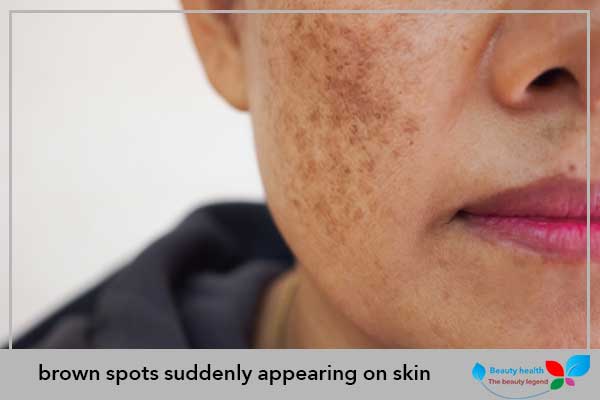brown spots suddenly appearing on skin
brown spots suddenly appearing on skin
brown spots suddenly appearing on skin | Many people notice the appearance of brown spots on many areas of the body, including the abdomen and chest, which causes inconvenience and gives the person an unfamiliar appearance and puts him in embarrassing situations, especially if these spots are visible in other places on the body.
Many wonder about the reasons behind the appearance of these spots and their treatment, and this is what we will learn about in this article from health beauty website :
The appearance of dark spots on the skin:
In order to know the reasons for the appearance of brown spots on the abdomen and chest, we must first know that the main factor related to everything related to the skin in general is melanin . Pigmentation, which is the appearance of dark spots on the skin:
- Increased production of melanin as a result of excessive exposure to ultraviolet rays leads to the appearance of those dark-colored spots.
- It is worth noting that the natural source of UV rays is exposure to sunlight.
The appearance of brown spots on the leg:
The appearance of brown spots on the leg may be more than a small appearance on the skin, they may be indicators that urge us to take better care of our body, as they can represent a sign of a serious disease that affects us such as diabetes :
- There are many reasons behind the appearance of brown spots on the leg, such as increased production of melanin, which accompanies most skin problems.
- The wrong use of cosmetics or the use of products that do not suit the nature of the skin can be the reason behind the appearance of these spots.
- Some types of medications can have side effects that cause these spots to appear.
- Hormonal changes in women, especially during pregnancy , can cause the appearance of these brown spots.
- Infections can also be behind the appearance of brown spots on the leg.
Treatment of brown spots on the leg:
- There are many ways to treat brown spots on the leg, such as laser treatment.
- Ointments that contain the aromatic organic compound “hydroquinone” and those that contain retinoic acid can be used to treat brown spots that appear on the leg.
The appearance of brown spots on the breast:
Many women face a skin problem represented by the appearance of brown spots on the breast, which is one of the most common skin problems that cause women inconvenience and embarrassment. The reasons behind the appearance of brown spots on the breast are many, including:
- Pregnancy and the accompanying hormonal changes in a woman’s body can lead to the appearance of brown spots on different places on a woman’s body, including the breast.
- Also, some other reasons can be behind the brown spots on the breast area, for example, the hair follicles in the breast area getting clogged.
- Infection with some infections such as “breast eczema”, which is accompanied by skin pigmentation, may also be one of the reasons.
- The contraceptive pill that a woman resorts to may cause brown spots to appear on the breast.
Treatment of dark spots on the breast:
- As for the methods of treating brown spots on the breast area, they can be treated in an easy way by taking more care of the cleanliness of the area by washing it with soap and water and quickly drying the area after washing.
- Brown spots on the breast area can also be treated by resorting to medical preparations such as anti-fungal ointments.
- But it is necessary to use medicinal preparations under medical supervision in order not to worsen the condition.
The appearance of brown spots on the skin in men (brown spots suddenly appearing on skin):
Many men of all ages are exposed to the problem of the appearance of brown spots on the skin, and this constitutes a disturbance for men, especially the youth group who take great care of their appearance. The reasons that lead to the appearance of brown spots on the skin in men are many, most notably:
- increased exposure to sunlight; So we find these spots very commonly in men who spend a lot of time in the sun.
- Increased exposure to sunlight is accompanied by an increase in melanin production and thus the appearance of spots that may be dark brown spots on the skin areas.
- Especially the areas most exposed to sunlight, such as the hands and face.
- In addition, advancing age can be accompanied by the appearance of brown spots on the skin of men, which are called “age spots”, and they often occur with the age of fifty.
- Light-skinned men are more likely to develop age spots than dark-skinned men.
Treatment of brown spots on the skin in men:
- The treatment of brown spots on the skin in men has many ways, the topical creams, on top of which is vitamin C.
- Cosmetic methods can be used for treatment, for example, by exfoliating the skin.
Brown spots on the back (brown spots suddenly appearing on skin):
Although the back is one of the areas that are rarely visible in front of others, skin problems that affect the back are a nuisance to many who suffer from it, such as bodybuilders who expose their bodies during sports tournaments. There are many reasons behind the appearance of brown spots on the back, including:
- The deterioration of the level of hormones in the body, especially in women during menopause, in addition to the hormonal changes that women experience during pregnancy.
- Genetic factors can also play a role in the development of brown spots on the back.
- Excessive intake of sugar is one of the reasons that lead to the appearance of brown spots on the back.
- Smoking, especially smoking excessively, can increase the likelihood of these brown spots appearing on the back.
Treatment of brown spots in the back:
As for the treatment of brown spots on the back, they can be treated in several ways:
- For example, cryotherapy can be resorted to by using liquid nitrogen, which eliminates the excess pigment in the skin, and we note the importance of medical supervision in this treatment.
- Chemical peels are also a reliable way to treat brown spots on the back.
- Through the use of a chemical solution that is placed on the skin and exfoliates the surface of the skin and thus grows new skin, medical supervision is also important in this method of treatment.
What causes brown spots to appear under the armpits (brown spots suddenly appearing on skin):
We learned about the reasons for the appearance of brown spots on the abdomen and chest. As for the spots that appear under the armpit, there are many reasons for them, including:
- It is common knowledge that the armpit area is one of the most sweaty areas of the body.
- Therefore, people resort to using deodorant, which may contain substances that play a role in the appearance of these dark spots on the skin under the armpit.
- Bad hair removal is also a personal hygiene factor that causes brown spots under the armpit.
Treating brown spots that appear under the armpits:
In order to treat brown spots that appear under the armpit, there are many ways, including:
- It is possible to resort to removing armpit hair from its roots and then using a skin lotion that takes on the task of lightening the color of the skin.
- You can also use a piece of lemon and massage the area under the armpits that appear stains with the use of warm water, and then wipe it using a bathroom purifier.
At the end of the article, brown spots suddenly appearing on skin:
In an article, we learned about the reasons for the brown spots suddenly appearing on skin, the most important reasons that lead to the appearance of dark spots on the skin in various areas of the body, and how they can be treated using medical methods and using home recipes used in folk medicine.
You can also learn about the medical treatment of melasma , what is melasma , and the best recipes for melasma treatment.






